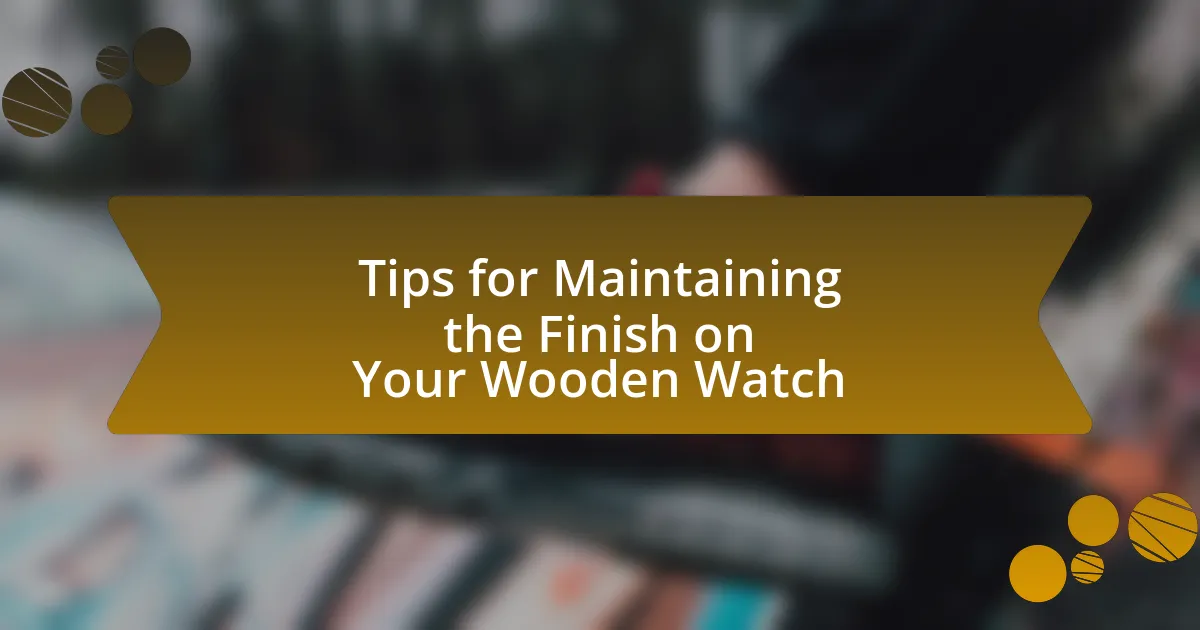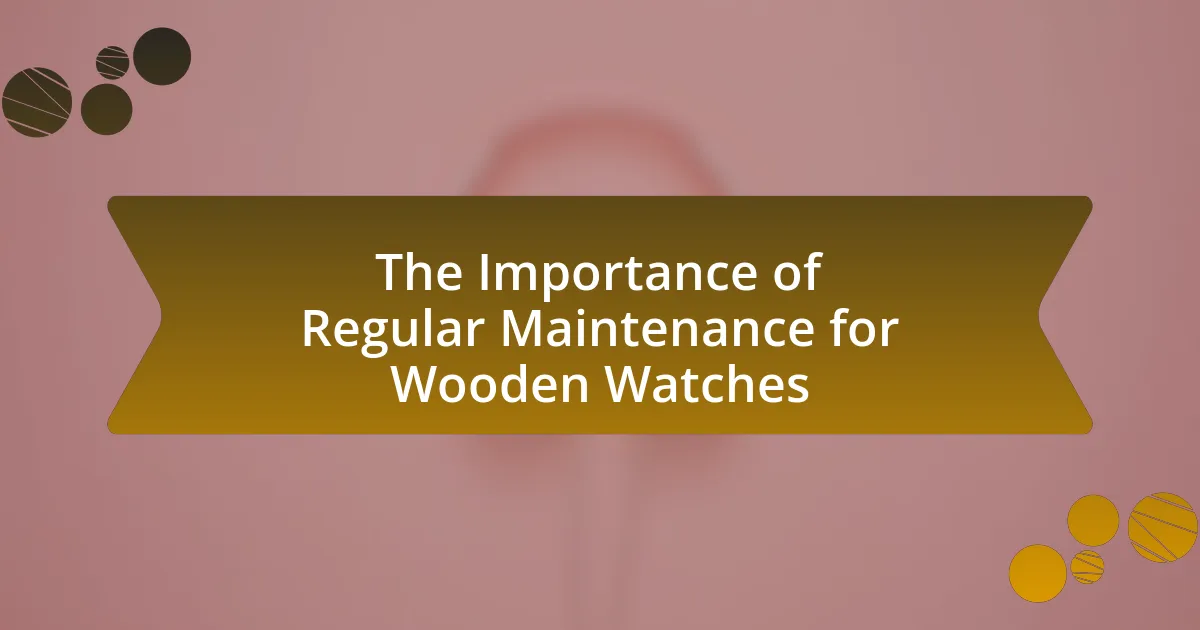The article focuses on the natural aging process of wooden watches, detailing how factors such as light exposure, humidity, and temperature influence changes in color, texture, and structural integrity over time. It explains that as wooden watches age, they develop a richer hue and unique patina, enhancing their aesthetic appeal. The article also emphasizes the importance of proper care and maintenance to preserve the watch’s appearance and durability, including regular cleaning and conditioning. Additionally, it addresses common misconceptions about the fragility of wooden watches and provides practical tips for owners to extend the lifespan of their timepieces.

What is the Natural Aging Process of Wooden Watches?
The natural aging process of wooden watches involves the gradual changes in color, texture, and structural integrity of the wood over time. As wooden watches age, they typically develop a richer hue due to exposure to light and air, which enhances their aesthetic appeal. Additionally, the wood may become more porous, leading to slight changes in weight and feel.
Factors such as humidity, temperature, and exposure to oils from skin can accelerate this aging process, causing the wood to expand or contract. Over time, the natural oils within the wood can also evaporate, potentially leading to a drier appearance if not maintained properly. Regular care, such as applying wood conditioner, can help preserve the watch’s integrity and appearance.
This aging process is a natural characteristic of wooden materials, reflecting their organic nature and contributing to the uniqueness of each piece.
How does the aging process affect the appearance of wooden watches?
The aging process causes wooden watches to develop a richer color and unique patina over time. As the wood ages, exposure to light and air leads to oxidation, which enhances the natural hues and grain patterns, making each watch distinct. Additionally, the wood may experience slight changes in texture and finish, contributing to a more organic and vintage appearance. This transformation is a natural characteristic of wood, as evidenced by studies showing that aged wood exhibits increased depth in color and complexity in grain, which are highly valued in craftsmanship.
What changes occur in the color and texture of wood over time?
Wood undergoes significant changes in color and texture over time due to exposure to light, air, and moisture. Initially, fresh wood appears lighter and may have a more uniform texture. As it ages, ultraviolet light causes the wood to darken and develop a richer hue, while oxidation and environmental factors contribute to variations in color. The texture of wood can also change; it may become smoother as the surface wears down or develop a patina, which adds depth and character. These transformations are well-documented in studies of wood aging, indicating that the aging process enhances the aesthetic appeal of wooden items, including watches.
How does exposure to light influence the aging of wooden watches?
Exposure to light accelerates the aging of wooden watches by causing degradation of the wood fibers and altering their color. Ultraviolet (UV) light, in particular, breaks down lignin, a component of wood that provides structural integrity, leading to brittleness and potential cracking. Additionally, prolonged exposure to light can result in fading of the wood’s natural hues, diminishing the aesthetic appeal of the watch. Studies have shown that wood exposed to sunlight can lose significant color intensity within a few months, indicating that light exposure is a critical factor in the aging process of wooden watches.
Why is understanding the aging process important for wooden watch owners?
Understanding the aging process is crucial for wooden watch owners because it directly impacts the watch’s durability, appearance, and functionality. As wood ages, it undergoes changes in color, texture, and structural integrity, which can affect the watch’s overall performance and aesthetic appeal. For instance, exposure to moisture can lead to warping or cracking, while prolonged sunlight can cause fading. Knowledge of these factors enables owners to implement proper care and maintenance strategies, such as avoiding extreme conditions and using appropriate cleaning methods, thereby prolonging the lifespan of their wooden watches.
What impact does aging have on the durability of wooden watches?
Aging negatively impacts the durability of wooden watches by causing the wood to dry out, leading to increased brittleness and susceptibility to cracking. Over time, exposure to environmental factors such as humidity and temperature fluctuations accelerates this drying process, which can compromise the structural integrity of the watch. Research indicates that wood loses moisture content as it ages, which can result in dimensional changes and a decrease in overall strength. For instance, studies have shown that wood can lose up to 20% of its moisture content over several years, significantly affecting its durability and longevity in watchmaking.
How can knowledge of aging enhance the appreciation of wooden watches?
Knowledge of aging enhances the appreciation of wooden watches by allowing individuals to understand the unique characteristics that develop over time, such as color changes, texture, and grain patterns. As wood ages, it undergoes natural processes like oxidation and drying, which can deepen its hue and enhance its visual appeal. For instance, certain woods like mahogany and oak become richer in color and more pronounced in grain with age, making each wooden watch a unique piece of art. This understanding fosters a deeper connection to the craftsmanship and the natural materials used, as well as an appreciation for the watch’s history and individuality.

What factors influence the aging process of wooden watches?
The aging process of wooden watches is influenced by factors such as humidity, temperature, exposure to sunlight, and the type of wood used. Humidity affects the moisture content in the wood, leading to expansion or contraction, which can cause warping or cracking. Temperature fluctuations can also impact the wood’s integrity, as extreme heat may dry it out while excessive cold can make it brittle. Sunlight exposure can lead to fading and discoloration, altering the watch’s appearance over time. Additionally, different wood species have varying densities and durability, which affects how they age; for instance, hardwoods like oak tend to age more slowly than softer woods like pine.
How do environmental conditions affect the aging of wooden watches?
Environmental conditions significantly influence the aging of wooden watches by affecting their moisture content, temperature stability, and exposure to sunlight. High humidity can lead to wood swelling and warping, while low humidity can cause cracking and drying out. Temperature fluctuations can accelerate the degradation of adhesives and finishes used in wooden watches. Additionally, prolonged exposure to sunlight can result in fading and discoloration of the wood. Studies have shown that wood is a hygroscopic material, meaning it absorbs and releases moisture based on environmental conditions, which directly impacts its structural integrity and appearance over time.
What role does humidity play in the aging process?
Humidity significantly affects the aging process of wooden watches by influencing the wood’s moisture content and structural integrity. High humidity can lead to wood swelling, which may cause warping or cracking, while low humidity can result in drying and shrinkage, compromising the watch’s durability. Research indicates that maintaining a stable humidity level between 40% and 60% is optimal for preserving wooden materials, as fluctuations outside this range can accelerate deterioration. This understanding is crucial for the longevity of wooden watches, as consistent humidity control helps mitigate damage and maintain their aesthetic and functional qualities.
How does temperature variation impact wooden watch longevity?
Temperature variation significantly impacts the longevity of wooden watches by causing the wood to expand and contract, which can lead to structural damage. When exposed to high temperatures, wood can dry out, resulting in cracks and warping, while low temperatures can cause moisture to accumulate, leading to swelling and potential mold growth. Research indicates that consistent temperature control can extend the lifespan of wooden items, as fluctuations can accelerate the aging process and compromise the integrity of the material.
What types of wood are commonly used in wooden watches, and how do they age?
Common types of wood used in wooden watches include bamboo, sandalwood, maple, walnut, and cherry. Each type of wood ages differently; for instance, bamboo is known for its durability and tends to darken over time, while sandalwood develops a richer aroma and color as it ages. Maple typically retains its light color but may show subtle changes in grain, whereas walnut darkens significantly, enhancing its visual appeal. Cherry wood also deepens in color, transitioning from a light pinkish hue to a darker reddish-brown. These aging processes are influenced by exposure to light, humidity, and the natural oils from skin contact, which can enhance the wood’s character and beauty over time.
What are the characteristics of popular woods used in watchmaking?
Popular woods used in watchmaking, such as mahogany, maple, and walnut, exhibit distinct characteristics that enhance their suitability for crafting timepieces. Mahogany is known for its durability and resistance to warping, making it ideal for intricate designs. Maple offers a fine grain and light color, which allows for detailed finishing and a polished appearance. Walnut, with its rich color and unique grain patterns, provides aesthetic appeal while maintaining structural integrity. These woods are chosen not only for their beauty but also for their ability to withstand the natural aging process, ensuring longevity and functionality in wooden watches.
How does the aging process differ among various types of wood?
The aging process differs among various types of wood primarily due to their cellular structure, density, and chemical composition. For instance, hardwoods like oak and maple age more slowly and develop a rich patina over time, while softwoods like pine and cedar tend to age more quickly and may show signs of wear and fading sooner. The lignin and cellulose content in hardwoods contributes to their durability and resistance to environmental factors, which affects how they age. In contrast, softwoods, being less dense, are more susceptible to moisture and UV damage, leading to a faster degradation process. This variance in aging is also influenced by the wood’s initial treatment and exposure to elements, which can either enhance or accelerate the aging process.

How can wooden watch owners care for their timepieces to manage aging?
Wooden watch owners can care for their timepieces to manage aging by regularly applying a suitable wood conditioner or oil to maintain moisture and prevent cracking. This practice helps preserve the wood’s natural luster and protects it from environmental factors such as humidity and temperature fluctuations, which can accelerate aging. Additionally, owners should avoid exposing their watches to water and extreme temperatures, as these conditions can lead to warping or damage. Regularly cleaning the watch with a soft, dry cloth also helps remove dirt and oils that can degrade the wood over time.
What maintenance practices can help preserve the appearance of wooden watches?
Regularly applying a natural oil, such as jojoba or linseed oil, helps preserve the appearance of wooden watches by maintaining moisture and preventing cracking. These oils penetrate the wood, enhancing its natural color and grain while providing a protective barrier against moisture and dirt. Additionally, avoiding exposure to direct sunlight and extreme temperatures prevents fading and warping, which can degrade the watch’s aesthetic over time. Cleaning the watch with a soft, dry cloth removes dust and prevents scratches, further preserving its appearance.
How often should wooden watches be cleaned and treated?
Wooden watches should be cleaned and treated every three to six months. Regular cleaning helps remove dirt and oils that can accumulate, while treatment with a suitable wood conditioner or oil protects the wood from moisture and enhances its longevity. This maintenance schedule is recommended to preserve the watch’s appearance and functionality, as untreated wood can become dry and susceptible to damage over time.
What products are recommended for maintaining wooden watches?
To maintain wooden watches, it is recommended to use natural oils, such as jojoba oil or mineral oil, which help nourish the wood and prevent drying. Additionally, a soft microfiber cloth is essential for cleaning the watch without scratching the surface. Regular application of these oils can enhance the wood’s appearance and longevity, as they penetrate the material and provide moisture. Using a microfiber cloth helps remove dust and dirt, ensuring the watch remains in optimal condition.
What are the best practices for storing wooden watches to minimize aging effects?
To minimize aging effects on wooden watches, store them in a cool, dry environment away from direct sunlight and humidity. Wood is sensitive to temperature and moisture fluctuations, which can lead to warping, cracking, or fading. Maintaining a stable environment with a relative humidity level between 40% and 60% is crucial, as excessive moisture can promote mold growth while too little can cause the wood to dry out and crack. Additionally, using a soft cloth to wrap the watch can protect it from dust and scratches, further preserving its condition. Proper storage in a dedicated watch box or case can also prevent exposure to elements that accelerate aging, such as heat sources or chemicals.
How should wooden watches be stored to avoid damage from environmental factors?
Wooden watches should be stored in a cool, dry place away from direct sunlight and humidity to avoid damage from environmental factors. Exposure to high temperatures and moisture can cause the wood to warp, crack, or lose its finish. Additionally, using a soft cloth or a dedicated watch box can help protect the watch from dust and scratches, further preserving its integrity. Proper storage conditions, such as maintaining a stable temperature and humidity level, are essential for prolonging the lifespan of wooden watches.
What storage conditions are ideal for prolonging the life of wooden watches?
The ideal storage conditions for prolonging the life of wooden watches include keeping them in a cool, dry environment with stable humidity levels between 40% and 60%. This range prevents the wood from warping or cracking due to excessive moisture or dryness. Additionally, storing wooden watches away from direct sunlight and extreme temperature fluctuations helps maintain their integrity and finish. Research indicates that exposure to high temperatures can lead to resin breakdown in the wood, while high humidity can promote mold growth, both of which can significantly shorten the lifespan of wooden timepieces.
What common misconceptions exist about the aging of wooden watches?
Common misconceptions about the aging of wooden watches include the belief that they deteriorate quickly and lose their aesthetic appeal over time. In reality, wooden watches can age gracefully, developing a unique patina that enhances their character. This natural aging process is influenced by factors such as the type of wood used, environmental conditions, and care practices. For instance, high-quality woods like mahogany or teak are known for their durability and resistance to wear, allowing them to maintain their beauty for years. Additionally, regular maintenance, such as oiling and proper storage, can significantly prolong the lifespan and appearance of wooden watches, countering the misconception that they are inherently fragile.
How do myths about wooden watch durability affect consumer choices?
Myths about wooden watch durability significantly influence consumer choices by creating misconceptions that can deter potential buyers. For instance, the belief that wooden watches are inherently fragile or prone to damage can lead consumers to favor metal or plastic alternatives, despite evidence showing that many wooden watches are treated for durability and can withstand daily wear. Research indicates that consumers often rely on perceived durability as a key factor in their purchasing decisions, which can be skewed by these myths. Consequently, brands that effectively communicate the durability of their wooden watches can counteract these myths and attract a broader customer base.
What truths should consumers know about the aging process of wood?
Consumers should know that the aging process of wood involves natural changes in color, texture, and structural integrity over time. As wood ages, it typically darkens due to exposure to light and air, which can enhance its aesthetic appeal. Additionally, the moisture content in wood decreases, leading to potential shrinkage or warping if not properly maintained. Research indicates that wood can lose up to 20% of its moisture content in the first year of aging, affecting its durability and appearance. Understanding these truths helps consumers make informed decisions about the care and longevity of wooden products, particularly in items like wooden watches.
What practical tips can enhance the longevity of wooden watches?
To enhance the longevity of wooden watches, regular maintenance is essential. This includes keeping the watch away from extreme temperatures and humidity, as wood can warp or crack under such conditions. Additionally, applying a natural oil or wax periodically can protect the wood from moisture and enhance its appearance. It is also important to avoid exposing the watch to water, as excessive moisture can damage the wood and the internal mechanisms. Finally, storing the watch in a dry, cool place when not in use will help preserve its condition over time.







































